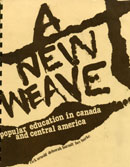
A New Weave
Popular Education in Canada and Central America
Arnold, Rick; Barndt, Deborah; Burke, Bev
Publisher: CUSO Development Education; Ontario Institute for Adult Education, Ottawa, Canada
Year First Published: {8227 A New Weave NEW WEAVE Popular Education in Canada and Central America Arnold, Rick; Barndt, Deborah; Burke, Bev CUSO Development Education; Ontario Institute for Adult Education Ottawa Canada A resource for educators working for social change in community groups, trade unions, churches, the peace movement, women's groups, international development organizations, Central America and other solidarity networks. 1986 1987 101pp $5 (reduced for large orders) BC8227-ANewWeave.jpg PMP Pamphlet 370.115 A New Weave is written for educators working for social change in community groups, trade unions, churches, the peace movement, women's groups, international development organizations, Central America and other solidarity networks.
<br>
<br>A New Weave begins with a look at Canadian education and organizing work since the turn of the century. It then briefly describes popular education in the Central American context.
<br>
<br>The second part of the book, "Some New Designs", selects four new ideas or designs from the Central American experience and reworks them for the Canadian context. In the final section, the authors fcous on tasks facing educators in Canada.
<br>
<br>The book is well illustrated and is full of practical ideas, suggestions, and examples of popular education.
<br>
<br>
<br>Table of Contents
<br>
<br>Educators as Weavers
<br>Popular Educators' Dictionary
<br>
<br>The Fabric of Our Lives
<br>Looking for our roots
<br>The Latin American Context
<br>Introducing Alforja: A Popular Education Network in Central America
<br>
<br>Some New Designs
<br>Another way of thinking
<br>The learning loom
<br>Naming the political movement
<br> -Monthly meetings
<br> -The Social Tree
<br>Creative program designs
<br>-Central American Solidarity events
<br>-Another design example: examining sexism
<br>New ways of doing old tasks
<br>
<br>Making Connections
<br>Some initiatives
<br>The Alforja Network as one model
<br>Making connections among ourselves
<br>
<br>Appendix
<br>Six member centres of Alforja
<br>Bibliography
<br>Feedback form CX3221 1 false true false CX3221.htm [0xc0009f1200 0xc00074f890 0xc00066dcb0 0xc00067e300 0xc001522090 0xc0016ea330 0xc0016eb440 0xc00086b800 0xc00007ba10 0xc0009c3b90] Cx}
Year Published: 1987
Pages: 101pp Price: $5 (reduced for large orders) Dewey: 370.115
Resource Type: Pamphlet
Cx Number: CX3221
A resource for educators working for social change in community groups, trade unions, churches, the peace movement, women's groups, international development organizations, Central America and other solidarity networks.
Abstract:
A New Weave is written for educators working for social change in community groups, trade unions, churches, the peace movement, women's groups, international development organizations, Central America and other solidarity networks.
A New Weave begins with a look at Canadian education and organizing work since the turn of the century. It then briefly describes popular education in the Central American context.
The second part of the book, "Some New Designs", selects four new ideas or designs from the Central American experience and reworks them for the Canadian context. In the final section, the authors fcous on tasks facing educators in Canada.
The book is well illustrated and is full of practical ideas, suggestions, and examples of popular education.
Table of Contents
Educators as Weavers
Popular Educators' Dictionary
The Fabric of Our Lives
Looking for our roots
The Latin American Context
Introducing Alforja: A Popular Education Network in Central America
Some New Designs
Another way of thinking
The learning loom
Naming the political movement
-Monthly meetings
-The Social Tree
Creative program designs
-Central American Solidarity events
-Another design example: examining sexism
New ways of doing old tasks
Making Connections
Some initiatives
The Alforja Network as one model
Making connections among ourselves
Appendix
Six member centres of Alforja
Bibliography
Feedback form
Subject Headings


